| |
Law and Enforcement
|
|
|
The strongest
deterrent against road use disobedience is strong enforcement
of the law. The Hong Kong Police — the guardians
of the road — ensure smooth traffic flows, check
careless or inconsiderate drivers, and monitor cyclists
and pedestrians with one objective in mind: to help minimise
the number of accidents and fatalities in Hong Kong. Whether
on foot or patrolling on motorcycles, the Police are there
to safeguard the community as a whole.
|
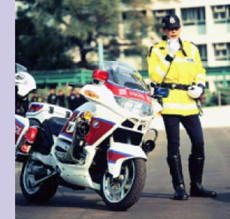 |
|
|
|
The total number of road accidents fell by
7.3 per cent in 2003 as against 2002, and the number of casualties
was the lowest on record for the past 25 years. But the number
of fatalities at 202 was up on the previous year's figure. One
accident alone accounted for 21 deaths when a double-decker bus
plunged over a hillside on the Tuen Mun Road on July 10 2003.
Hong Kong continues to maintain its relatively positive rate of
30 fatalities per million of population, which is significantly
lower than most cities of a similar size. However, a single road
accident, death or injury is one too many, and stringent enforcement
action against traffic offenders is being maintained with determination
to make Hong Kong an even safer place to drive and walk.
|
| |
Legislative Review
|
| |
|
Taking into account the successful implementation of seat belts for drivers and passengers in private cars, goods vehicles and taxis, legislation will be introduced in 2004 to make it compulsory for all public light buses registered on or after 1 August 2004 to be fitted with seat belts and high back seats for passengers. Passengers not "belting-up" on board a public light bus fitted with safety seat belts will be liable to prosecution. Major publicity will be afforded to the new legislation, followed up by enforcement. |
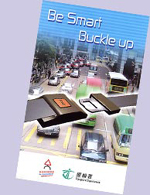 |
|
| |
|
The Government plans to make
common traffic offences subject to on-the-spot fines (an extension
of the fixed penalty system), step up driver training and to examine
issuing newly licensed drivers with one-year probationary "P"
plates. In view of the fact that following too close to the vehicle
in the front is a common accident contributory factor, the Administration
is now exploring the introduction of a specific offence for 'tailgating'
to combat this problem and to enhance road safety.
|
| |
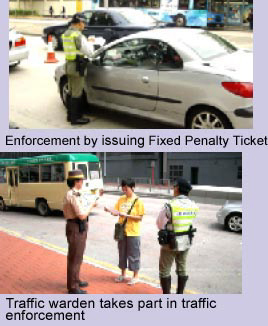 |
The Selective
Traffic Enforcement Policy (STEP) |
| |
|
Each year the Police Force carry out
a thorough review of the major traffic accident contributory
factors; the findings of which set the pattern not only
for the Selective Traffic Enforcement Policy, but also
the overall publicity campaigns. STEP, the backbone of
enforcement policy, focuses on offences which cause or
are most likely to cause accidents. For example, in recent
years STEP has steered the Force towards strengthening
our focused enforcement against specific road user groups:
motorcyclists, cyclists and pedestrians who flout the
law, endangering their own lives and those of others.
|
|
| |
|
Improvements
in technology are also making an increasing contribution
to enforcement initiatives and 2003 saw the growing use
of information technology in enhancing enforcement capabilities
and in the securing of evidence.
Speeding — As speeding continues to be a major contributory factor in the incidence and severity of accidents, the Police place a strong focus on the offence by maximising road patrols with the use of new speed enforcement technology and heavy penalties to deter offenders. |
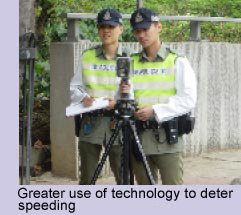
|
|
| |
|
Drink
Driving — Drink driving is another major
focus for enforcement activities. The situation is improving
and there now appears to be a high awareness of the problem
and drink driving is generally seen as anti-social behaviour.
Most drivers now control their drinking habits and refrain
from alcohol consumption if they are going to drive. This
change in attitude has come about through drink driving
legislation which has been in force since 1995 and the
subsequent tightening of the alcohol limit from 35μg
to 22μg per 100 ml of breath in 1999.
In 2003,
41,340 drivers were breathalysed, with 1,390 subsequently
found to be above the prescribed limit. This translates
to a rate of 3.4 per cent which is in line with the rate
recorded in
|
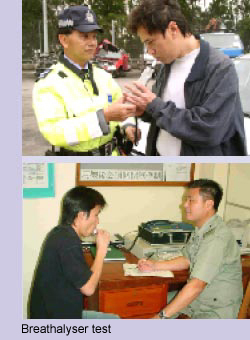 |
|
|
previous years. A positive finding of these
results was the fact that a very high number of those tested,
39,476 (95.5 per cent) had no trace of alcohol in their test results,
indicating that Hong Kong drivers are generally law abiding in
this respect. However, vigilance is still necessary. We will continue
with our ongoing training among police officers on the observation
and testing for drink driving.
|
| |
| The Growing Use of Information Technology |
| |
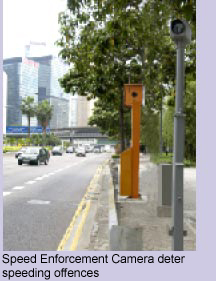 |
Speed
Enforcement Cameras (SECs) — SEC systems
on Hong Kong's expressways have proven to be an effective
deterrent leading to a marked reduction in the number
of accidents and injuries. Believing that prevention is
better than cure, the speed cameras are conspicuously
placed along the roadside for all drivers to see and to
serve as a reminder to keep within the marked speed limit.
To make them even more conspicuous, there is a programme
to paint the cameras and their stands into a bright orange!
No longer will the SECs be considered a "speed trap",
but rather a "speed warning." Those, however,
who ignore the warning will be captured on film and subsequently
prosecuted. Also, the location of speed enforcement cameras
are promulgated on the Police homepage and updated monthly.
|
|
| |
|
The 10 operational SECs were recently
expanded with an additional eight cameras to be rotated
amongst an additional 75 sites on the expressways. These
additional cameras are digitalised to enhance efficiency.
There are plans for further expansion of the use of SEC
by the Transport Department and the Police.
Red Light Cameras (RLCs) — By the end of 2003, 51 signalised road junctions at strategic locations were installed with red light cameras to deter motorists from disobeying traffic signals. This programme has been further expanded during 2004 with an additional 60 sites and 12 digital cameras put into operation. |
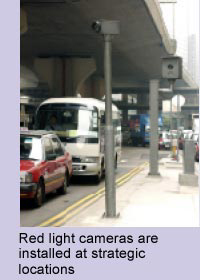 |
|
|
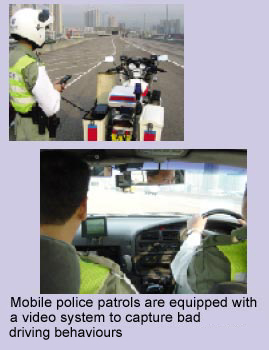 |
Automatic Non-stopper
Traffic Enforcement Computer System (ANTECS) —
The ANTECS came on-line in early 2002. The system, operated
in conjunction with the Transport Department, reinforces
police enforcement capabilities, allowing them to process
and prosecute traffic offences, even when offenders have
not been stopped at the scene. The system is linked to hundreds
of highway camera sites which have proved to be very effective.
|
|
| |
Video Systems — The Police continue to use mobile camera systems to enhance safety on Hong Kong's roads. Some 32 police patrol cars and 15 motorcycles are now equipped with these video systems to record speeding offences and other dangerous driving habits, including tailgating and improper lane changing. |
| |
| General Safety |
| |
|
The enforcement of general safety legislation continued during the year. In view of the proven link between the use of seat belts and the reduced risk of death and severity of injury in traffic accidents, police continue to focus on enforcement in this area. In 2003, police prosecuted 18,292 drivers and passengers for seat belt related offences. Similarly, enforcing the ban on hand-held mobile phones and telecommunications equipment when driving, the Police have prosecuted 6,188 drivers for using such equipment. |
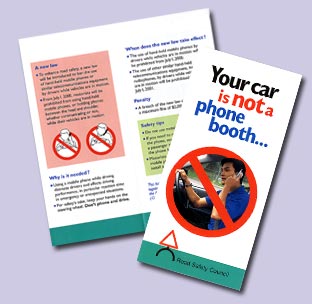 |
|
|
|
| Almost every month, the Police launch" Traffic Days" in Regions and Districts during which there is a blitz of enforcement on road users violating traffic regulations with a view to reminding the road users of the importance of road safety. |
| |
|
Driving Improvement
Scheme
|
| |
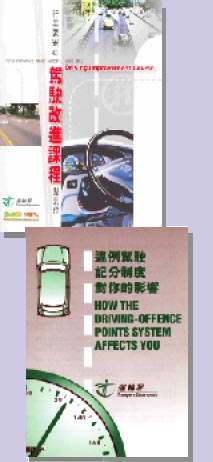 |
Based on studies in many developed
countries, the Drivers' Improvement Scheme (DIS) has
led to a decrease in traffic accidents and a conspicuous
change in driving attitude. At the end of 2002, the
scheme was introduced in Hong Kong to:
Empower courts to direct drivers who have committed
scheduled offences incurring five driving-offence points
or above under the Road Traffic (Driving-Offence Points)
Ordinance to attend a driving improvement course as one
of the penalties; and
Allow drivers to join a driving improvement course voluntarily.
The incentive is that those who successfully complete
the course will have three driving offence points deducted
from his total driving-offence points already incurred.
During 2003, some 1,391 drivers attended the course,
either by order of the Court (11) or voluntarily (1,380).
|
|









